Pollen Feeder for Bees-Make Your Own
You can make your own pollen feeder for bees using a few simple pieces of PVC pipe. Honey bee colonies must have protein in order to thrive but nature doesn’t always provide enough. Part of the beekeeper’s job is understanding the needs of the colony. Offering bees a pollen substitute in times of need can make a positive difference in colony strength.
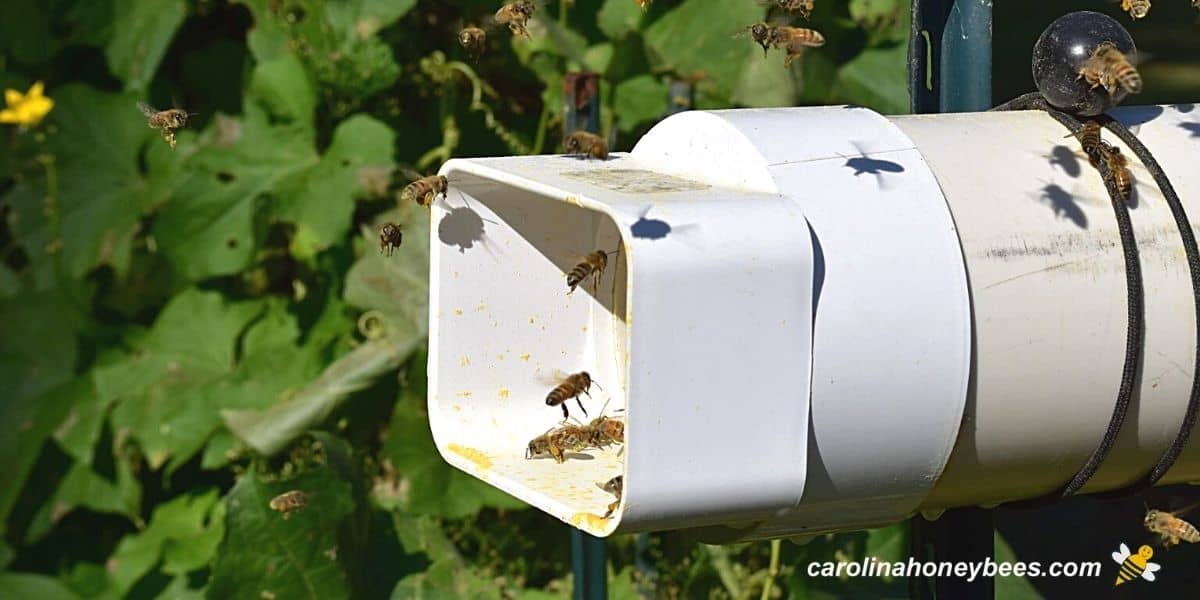
Over my years of beekeeping experience, I have come to realize the times of the year when my bees may be serious need of pollen supplement. This is one part of successful beehive management.
How to Make a Pollen Feeder for Bees
It is a common practice for beekeepers to offer protein or pollen substitutes to their hives. Even strong colonies may experience a shortage of the resources bees need to collect.
In some situations, beekeepers prepare pollen patties to be fed inside the hive. But, you can offer dry pollen substitute too. I am going to show you a simple way to make your own pollen feeder for your honey bees.
Feeders used to provide dry pollen/substitute can be as simple or as complex as you desire. You can purchase pre-made feeders in a variety of styles.
Some of them are useful but outrageously expensive for what they are. (I mean seriously people – it’s basically a plastic tube!) If you enjoy a good bee project, it is relatively easy to make your own PVC pollen feeder.
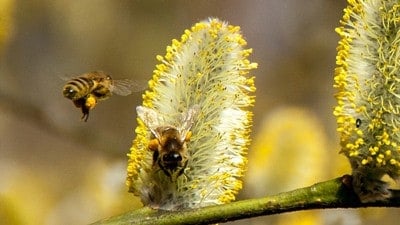
This post may contain affiliate links. As an Amazon Associate, I earn from qualifying purchases. Please read my disclosure.
Materials
All of the supplies needed to make your pollen feeder are easily acquired at any home improvement store.
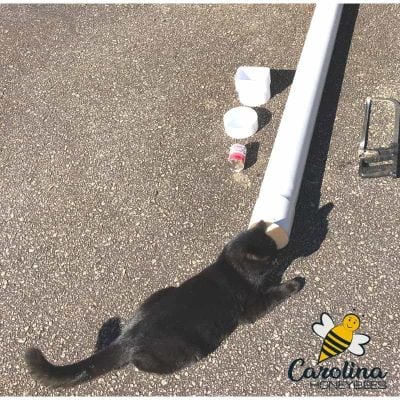
Let’s do it.
- 12″ length of 4″ diameter thin wall PVC pipe
- 1 piece End Cap to fit the pipe (4″ PVC)
- 1 piece PVC Drain Downspout Adapter (4″)
- 1 bottle PVC Glue
- 1 bag pollen substitute
You need a section of thin walled PVC pipe with a 4″ diameter. This pipe is found in the drain or gutter section of home improvement stores. If you have another type of pipe, you can use it but be sure the fittings will fit.
As I mentioned, if you purchase this pipe at Home Depot or similar, it comes in a 10′ section. A nice associate cut it in half for easy hauling.
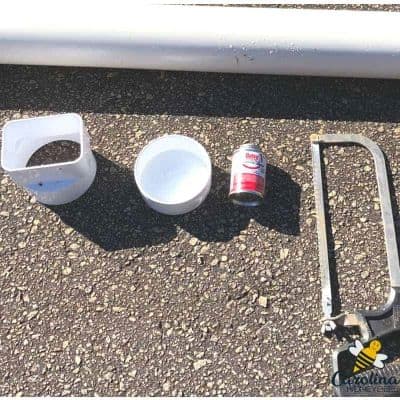
You will also need an End Cap to fit the 4″ pipe. We want to close off one end of the feeder. This aids in keeping the pollen dry even in windy, rainy weather.
To create an entrance for the bees and still keep most of the food inside the pipe, use a Drain Downspout Adapter. It will fit on our 4″ pipe and have a square opening for the bees.
Many home owners have some PVC glue around the house. You will need a small amount to glue the end cap and Drain Downspout Adapter onto our section of pipe.
And, you need a hacksaw to cut the pipe to the best length. While you can make the feeder any size, a length of 8″-12″ seems to work well.
If you have concerns about cutting the pipe, or maybe you don’t have a hacksaw? I have found most store associates willing to help when asked nicely.
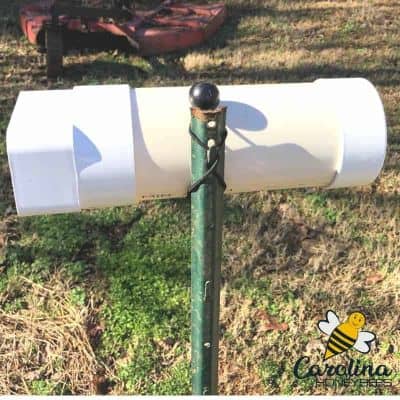
Where to Place Your Bee Pollen Feeder
- off the ground or protected from animals
- away from the bee yard
- easily accessible for the beekeeper
I have found it best to locate the pollen feeder up off the ground. Bees are not the only things that like pollen substitute. Cats, Raccoons, Opossums and my own goats have enjoyed a feast on occasion.
A portable garden t-post and a bungee cord works very well. We want a slight downward tilt on the feeder-just in case of rain.
Normally, I only put a small amount of pollen substitute in the feeder at a time. This is just in case a mishap occurs, good protein sub is not cheap. If I want to put out a larger amount, I will place my feeder inside a wire cage.
Those without a lot of foragers or in the colder months of the year may not be able to access the outside feeder. Most honey bees do not fly on a true rainy day.
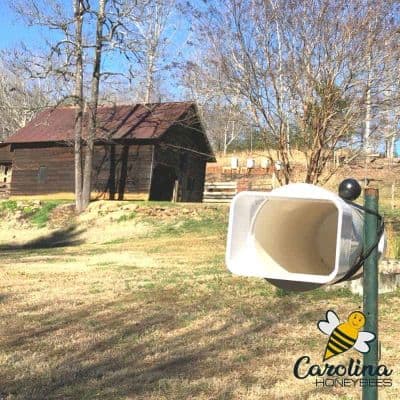
Locate Protein Feeders Well Away From Your Beehives
It is not necessary to place your feeder too close to the hives. In fact, I hesitate to put any food source near the hives.
I do not want to attract any honey bee predators to the bee yard. Remember, honey bees can fly.
Put your feeder in an easily accessible location. But, there will be a lot of bee activity at the feeder sometimes- don’t place it too close to the house or play area.
This is often put outside the hive in a location accessible to the bees but protected from rain. It does not have to be close to the hives and honestly should be at least 50 feet away.
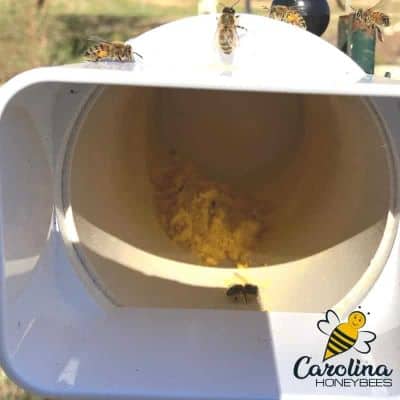
Fill the Pollen Feeder
Within just a few minutes of installation, several worker bees had found my feeder. If the weather is warm enough for bee flight, most colonies locate the protein source within a day or so.
One of my favorite dry pollen substitutes is Ultra Bee from Mann Lake. The bees seem to like it very well. Because it is not cheap, I only put out about 1/2 cup at a time.
Expert Tips
The PVC pollen feeder is easy to make and relatively inexpensive. This is especially true if you can find someone to share costs with – perhaps a member of the local beekeeping association?
The 4″ thin wall PVC pipe usually comes in 10′ lengths! Try to acquire pipe locally.
This feeder is one of my favorite ways of supplementing pollen for my bee colonies. But, it may not be the best way to give protein to weak colonies with a small work force.
If your budget is really tight, bees in need will feed from a small amount of pollen on a plate outside. But other animals will eat the pollen too and it is not protected from rain.
Your bees will not always want to use your feeder. If there is an abundance of natural food, they will collect that instead.
A Final Word
Due to the difficulty involved in collecting fresh pollen and preventing spoilage, beekeepers often rely on pollen substitutes. The pollen feeder is only used as a support system in times of need.
Make your own pollen feeder for your bees – it is a lot of fun to watch them at work. Also, it provides some needed protein for colonies that are low on protein stores.
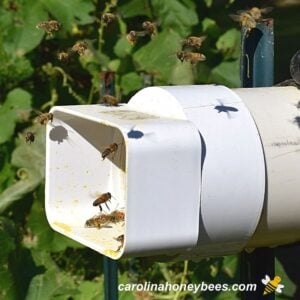
How to Make a Pollen Feeder – Step by Step
This post may contain affiliate links. As an Amazon Associate, I earn from qualifying purchases.
Read my Disclosure.Tools
- Hacksaw
Supplies
- 1 piece 12" length of 4″ diameter thin wall PVC pipe
- 1 piece End Cap to fit the pipe (4″ PVC)
- 1 piece PVC Drain Downspout Adapter (4")
- 1 bottle PVC Glue
- 1 bag dry pollen substitute-Ultra Bee (or similar)
Instructions
- Cut feeder to length: Thin walled PVC is very easy to cut. A decent hacksaw will make quick work of the job. A longer feeder will hold more food. But, it will also be more difficult for the bees to navigate.Cutting the pipe to a length of 8"-10" seems to work well. The best news is you don't have to worry about cutting straight. Your fittings will cover any uneven edges.

- Glue end cap on one end: Now, it’s time to close one end of our section of pipe. Use the PVC cement (adhesive) to glue on the end cap. Avoid getting it on your hands – as it is hard to remove.You do not have to worry about a tight seal. We are not trying to make the pipe water tight. A light coating of cement will work fine.

- Attach drain downspout adapter: Glue the Drain Downspout Adapter to the other end of our PVC pollen feeder pipe. This will provide an entrance for the bees while keeping our substitute safely inside.

- Allow feeder assembly to dry: Give the feeder a few minutes to set and then find a good place to hang it for your hungry bees.






